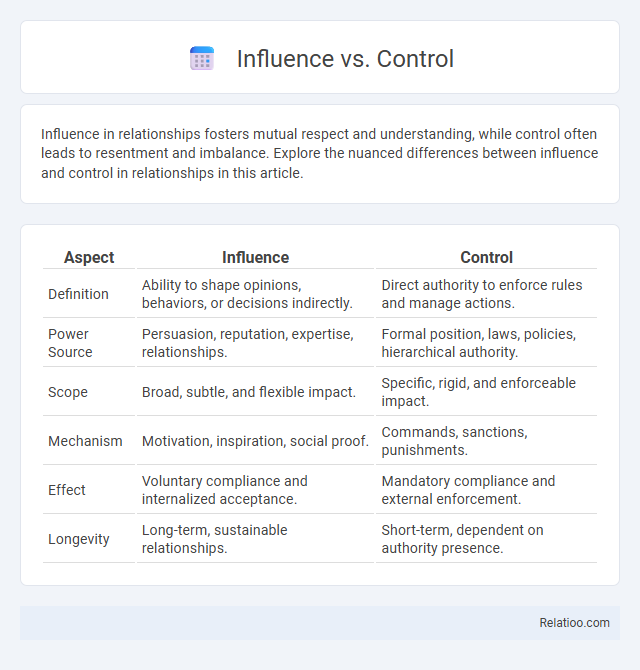Influence in relationships fosters mutual respect and understanding, while control often leads to resentment and imbalance. Explore the nuanced differences between influence and control in relationships in this article.
Table of Comparison
| Aspect | Influence | Control |
|---|---|---|
| Definition | Ability to shape opinions, behaviors, or decisions indirectly. | Direct authority to enforce rules and manage actions. |
| Power Source | Persuasion, reputation, expertise, relationships. | Formal position, laws, policies, hierarchical authority. |
| Scope | Broad, subtle, and flexible impact. | Specific, rigid, and enforceable impact. |
| Mechanism | Motivation, inspiration, social proof. | Commands, sanctions, punishments. |
| Effect | Voluntary compliance and internalized acceptance. | Mandatory compliance and external enforcement. |
| Longevity | Long-term, sustainable relationships. | Short-term, dependent on authority presence. |
Defining Influence and Control
Influence involves guiding or shaping others' behaviors and decisions through persuasion, trust, and credibility without direct authority. Control refers to the explicit power or authority to enforce rules, make decisions, and impose consequences to ensure compliance. While influence relies on voluntary acceptance and internal motivation, control depends on formal mechanisms and external enforcement.
Key Differences Between Influence and Control
Influence shapes outcomes by guiding decisions through persuasion, while control enforces outcomes by imposing rules or commands. Your ability to influence relies on building trust and credibility, whereas control depends on authority and power. Understanding these distinctions helps you foster cooperation rather than compliance, leading to more sustainable and motivated engagement.
Psychological Foundations of Influence
The psychological foundations of influence are rooted in principles such as reciprocity, social proof, authority, liking, and consistency, which shape human behavior more subtly than control or compliance mechanisms. Influence leverages internal motivations and perceptions, encouraging voluntary adoption of ideas or actions, whereas control relies on direct power and compliance depends on external enforcement. Understanding cognitive biases and emotional triggers enhances the effectiveness of influence by aligning messages with individuals' intrinsic values and decision-making processes.
The Nature of Control in Human Behavior
Control in human behavior is characterized by exerting direct power to regulate or command actions, often through rules, authority, or enforcement mechanisms. Influence operates subtly by shaping attitudes and decisions without overt authority, while compliance denotes outward conformity to directives, sometimes regardless of internal agreement. Your understanding of control highlights its coercive nature contrasted with influence's persuasive approach and compliance's behavioral adherence.
Influence vs Control in Leadership
Influence in leadership is about inspiring and guiding Your team through trust, communication, and shared vision, whereas control relies on authority, rules, and enforcement to dictate behavior. Effective leaders prioritize influence to foster engagement, creativity, and commitment, making team members feel valued and motivated intrinsically. Control, while necessary in certain situations, often stifles innovation and reduces autonomy, limiting long-term growth and collaboration.
Social Dynamics: Persuasion or Domination?
Influence shapes Social Dynamics by guiding Your behavior through persuasion, fostering cooperation and mutual understanding. Control imposes authority, often relying on domination to enforce compliance, which can limit autonomy and stifle creativity. Compliance results from adapting to external pressures or rules, reflecting the balance between voluntary agreement and submission within social interactions.
Real-World Examples: Influence and Control at Work
Influence at work often manifests through mentorship and persuasion, such as a manager inspiring a team to exceed goals by fostering trust and shared vision, while control is evident in hierarchical enforcement like setting mandatory project deadlines or strict quality standards. Compliance occurs when employees adhere to company policies or regulatory requirements, for example, following cybersecurity protocols enforced by IT departments. Real-world examples highlight that influence drives voluntary commitment, control ensures rule enforcement, and compliance guarantees alignment with organizational mandates.
Long-term Effects of Influence Compared to Control
Influence fosters lasting behavioral change by motivating intrinsic commitment, while control often leads to compliance driven by external pressure and temporary obedience. Your ability to influence builds trust and encourages proactive engagement, creating sustainable relationships and organizational culture. Long-term effects of influence include increased innovation, resilience, and loyalty, which control struggles to achieve without causing resistance or dissatisfaction.
Building Healthy Relationships: Choosing Influence Over Control
Building healthy relationships thrives on influence rather than control, fostering trust and mutual respect. Influence encourages collaboration and open communication, while control often leads to resistance and resentment. Emphasizing influence promotes sustainable connections and empowers individuals to contribute authentically.
Strategies to Shift from Control to Influence
Shifting from control to influence involves adopting collaborative strategies such as active listening, empathy, and empowerment to foster trust and intrinsic motivation. Emphasizing shared goals and open communication encourages voluntary compliance and strengthens relationships without relying on authority or mandates. Implementing feedback loops and recognizing contributions further amplifies influence by creating a culture of mutual respect and engagement.

Infographic: Influence vs Control
 relatioo.com
relatioo.com